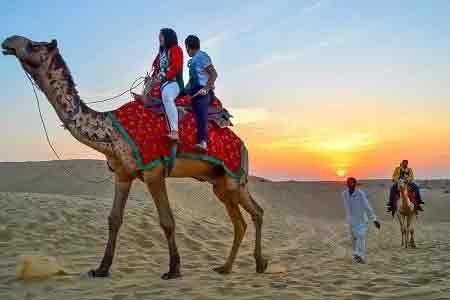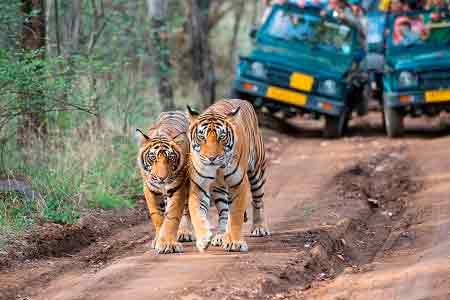

Jhalawar, once called Brijnagar is known for its rich natural wealth of vibrant flora and fauna. However, unlike other cities of Rajasthan, Jhalawar has a rocky but water-laden verdant landscape. Red poppy fields and orange laden orchards are strewn across Jhalawar, lending it a colourful look. They also contribute a major share to the production of citrus in the country. This place has a varied cultural heritage that includes many forts and palaces from the Rajput and Mughal periods.
Jhalawar fort
Situated in the centre of the town, the Jhalawar fort or Garh Palace is a beautiful monument. It was built by Maharaj Rana Madan Singh and his successors added beautiful paintings inside the rooms. These can be seen with the permission of appropriate authorities. The Zenana Khas or the ‘Women’s Palace’ has some excellent frescoes on both, walls and mirrors and they are prime examples of the Hadoti school of art.
Jhalawar Government Museum
The Jhalawar Government Museum is one of the oldest museums in Rajasthan established in 1915 A.D and has a fine collection of rare paintings, manuscripts and idols. The museum is situated bang in the middle of the city and is also a part of the Fort Palace. This ancient structure is a great tourist attraction.
Bhawani Natyashala
The Bhawani Natyashala is one of the most unusual theatres in India, constructed in 1921 A.D where Parsi plays and cultural events would take place. This architectural wonder gives one an excellent insight into the world of theatre and art and is known to have an underground passage which allowed horses and chariots to appear on stage.
Gagron Fort
Gagron Fort is a fine example of a hill and water fort. It is one of the six hill forts of Rajasthan to be a part of the UNESCO World Heritage Site list. Surrounded by the tranquil waters of the Ahu, Kali and Sindh rivers on three sides, the fort is indeed a sight to behold. A beautiful mausoleum of Sufi saint Mitheshah just outside the fort is the venue for an annual colourful fair held during the month of Moharram.
Chandrabhaga Temple
On the banks of the magnificent Chandrabhaga River stand some beautiful Chandrabhaga temples with intricately carved pillars and arched gateways. This region is known for the Shri Dwarkadheesh Temple that was built by Jhala Zalim Singh in the 11th century and the Shantinath Jain Temple which has houses some beautiful murals and sculptures.
Sun Temple
The finest temple of jhalrapatan is the 97-ft high, 10th-century temple dedicated to Lord Shiva. It is popularly known as the Padmanabha or Sun Temple. Similar to the Sun temple in Konark in Orissa, the temple is crowned with a finely carved shikhara (spire). This high steeple is an amalgamation of miniature towers which seem to stick to the main tower, making it a unique one by itself. The shikhara is built in layers and the size of the pillars decreases as height increases, following a seven storey pillar format. The base of the shikhara is made up of larger pillars close to each other around the main foundation. This temple was first restored in the 16th century and later in the 19th century. The columns and arches at the entrance are richly carved with images of gods, goddesses and other Hindu motifs. Also worth seeing are old tiles engraved with figures of the gods-Vishnu and Krishna-on the outside walls of the temple.
Dwarkadheesh Temple
Another gift from the founder of the city of Jhalawar, Jhala Zalim Singh, is the Dwarkadheesh Temple. The temple was built in 1796 AD on the banks of Gomati Sagar Lake. In 1806 A.D, the idol of lord Krishna was installed here.
Dalhanpurb
Dalhanpur stands on the banks of River Chhapi, close to an irrigation dam. A dense green forest adds charm to this antique place with beautifully carved pillars, torans and some erotic figures in the temple ruins, scattered around an area of 2 Kms. At present, conservation and renovation work is under progress.




































Rajasthan Tour Packages are arguably the most sought after holiday packages in India. The very name Rajasthan conjures up the image of hill top fortresses, maharajas with scimitars riding the painted elephants, the exquisitely carved havelis. Our Rajasthan tour packages the camel safari in the sam sand dunes of Thar in Jaisalmer and Bikaner to the abundant wildlife of Ranthambore and Bharatpur, Explore the World Heritage Hill Forts of Rajasthan, marvel at the frescoes and havelis, have a wild run at Ranthambore or shop till you drop at the vibrant bazaars in Jaipur, Jodhpur and Udaipur and not to mention the planets biggest cattle fair in Pushkar.